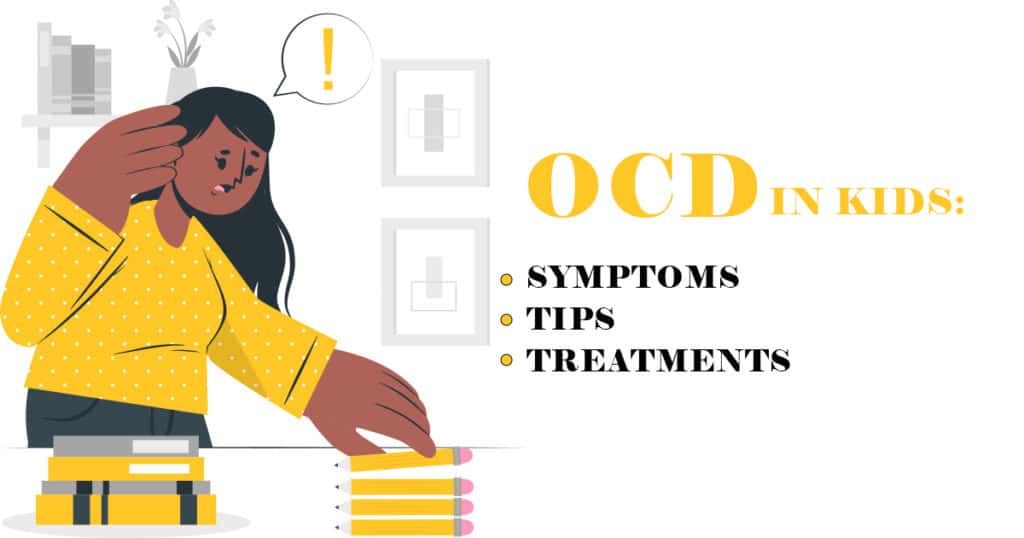It’s not easy to cope with OCD in Kids, but treatment options can and do work. We encourage you to contact us and learn more about therapy for OCD. Some children and teenagers can also have other disorders and OCD, such as severe anxiety, defiant disorder, or attention-deficit/hyperactivity disorder. In this case, treatment will need to include both conditions.
What is OCD?
Obsessive-Compulsive Disorder (OCD) is a mental health disorder affecting people of all ages. Obsessions and compulsions characterize the condition.
- An obsession is an intrusive, unwanted thought, urge, or image.
- Obsessions create a strong sense of distress for the person experiencing them.
- Compulsions are behaviors.
- A person engages in compulsions to try and reduce the distress they’re feeling from their obsessions or “get rid” of them.
Almost everyone will have both obsessive thoughts and compulsive behaviors in their lives, but that doesn’t mean they have OCD. For a diagnosis, the cycle has to be extreme, consume a significant amount of time, and get in the way of other aspects of the person’s life.
There are similarities between OCD and anxiety disorders, and effective treatment options tend to be similar to one another as well.
Understanding Obsessions and Compulsions
Someone with OCD doesn’t want the recurring thoughts, impulses, or images they experience. Most people who have this mental health disorder understand and fully realize their ideas aren’t logical and don’t make sense. These obsessions often include intense feelings of disgust and fear.
We often use the term obsessed casually in our daily lives. For example, you might hear people say they’re obsessed with a specific TV show or doing a particular hobby. That’s not the same thing as what someone with diagnosable OCD experiences. These are usually things they enjoy. Obsessions cause extreme anxiety, on the other hand.
Compulsions are repetitive behaviors. A person with this mental disorder might repeat behaviors to try and neutralize or counteract their obsessions. If you have obsessive-compulsive disorder, you usually realize you’re using a temporary solution, but that momentary escape can feel better than the alternative.
Not all repetitive behaviors are compulsions, nor are all rituals.
Someone with obsessive-compulsive disorder will usually not want to do the activities considered compulsions. They find them upsetting and time-consuming, but they feel like they have to do them to reduce their anxiety or escape their obsessions rather than because they want to.
Obsessive-Compulsive Disorder In Children and Teens: What’s It Like?
OCD can affect people of any age, including children and teens. Just like an adult with the disorder, OCD in kids and adolescents can include unwanted thoughts and worries and repetitive behaviors to calm obsession-driven anxiety.
Compulsions aren’t necessarily logically tied to obsessions.
For example, a young person might have a ritual like turning their bedroom light on and off a certain number of times to keep their parents from being hurt. The ritual doesn’t connect to the fear, and they’ll know it doesn’t make sense, but they still somehow feel that whatever they’re doing will keep their parents safe.
The onset age for the appearance of symptoms of OCD is usually around five years old; If a child is this young with the disorder, they may not yet understand their fears and thoughts aren’t realistic or are exaggerated.
Children and teens may try to hide their rituals in certain situations, such as act school, and then they’ll lash out or act out at home.
There’s also a condition called PANS or PANDAS, where children develop symptoms of obsessive-compulsive disorder after an infection. For example, some young people may develop OCD after a strep throat infection because of an autoimmune reaction.
OCD Symptoms in Children and Teens
Some of the relatively common obsessive-compulsive symptoms in children and teens can include:
- A fear of contamination can occur, including vomit, waste, germs, a fear of dirt or dirty objects, etc.
- Wanting everything to be symmetrical
- Severe fears about safety, such as worries about a house fire
- Fears of doing something terrible or violent
Compulsive rituals that are common in young people include:
- Repeated excessive hand washing
- Locking and relocking doors a particular number of times
- Touching both parts of their body in a symmetrical way
- Lining objects up
- Mentally repeating something
- Repeatedly asking for reassurance
A child or teen’s compulsions can be mental, like counting to a certain number in their head, so they’re harder to spot in these cases.
For a diagnosis, a young person must have obsessions, compulsions, or both, which impact their ability to live a normal life.
Symptom severity assessment follows a rating scale called the Yale-Brown Obsessive-Compulsive Scale.
Treating OCD in Kids and Teenagers
The best approach to treating both young people and adults with OCD is behavioral treatment or therapy. A licensed mental health professional may use cognitive behavioral therapy or CBT. More specifically, one of the best approaches to therapy for these psychiatric symptoms is a type of cognitive therapy known as exposure and response prevention (ERP).
The goal of ERP is to help kids learn to face their fears through exposure without then engaging in their compulsions, which is response prevention.
Psychologists, social workers, or counselors may guide a teenager through ERP. Children and teenagers participating in ERP learn they can let their obsessions and the anxiety they create go without performing compulsions or rituals.
Psychiatric medication can be an option less commonly, but only if ERP doesn’t help the symptoms alone.
A selective serotonin reuptake inhibitor or SSRI can help with OCD symptoms in children and teens. Medicines can be used along with therapy to improve the effectiveness and outcome.
How To Help Your Child with Obsessive Compulsive Disorder
Along with making sure you’re working with a qualified therapist or mental health provider, you can do some other things as a parent of a child with this disorder.
A few tips for managing OCD in kids and adolescents include:
- Ensure that you’re consistent in your approaches with your child and that other family members are as well.
- Don’t enable your child. Even though you may be well-intentioned, by accommodating their behaviors related to their OCD, you’re reinforcing it. Enabling or supporting the behavior might include changing your plans because of your child’s symptoms or going overboard in providing reassurance.
- Don’t encourage these behaviors or model them yourself. If you also have symptoms of obsessive-compulsive disorder, get your own treatment as well. You can have open discussions with your child about sharing what they’re going through.
- Even though it’s hard to see your child feeling distressed, you need to set limits. There may be outbursts that occur when setting these limits but staying consistent. While it’s tough at first, having boundaries can make your child feel less anxious over the longer term.
- Give praise when your child makes an effort to manage their OCD. You can say they did a good job with something. You don’t need to be excessive in the praise—keep it simple because it can become excessive reassurance.
- Be active in your child’s treatment. You should have a relationship with their therapist to learn how to best manage symptoms between your sessions. You can also do some of the ERP methods at home in your daily routine so that you’re continuously working for maximum benefits from their therapy.
If you’re looking to do all you can to help treat your teen with OCD in California, call 855-746-8378 and speak with a member of the Hillside Horizon for Teens team to learn more about how we can help.





